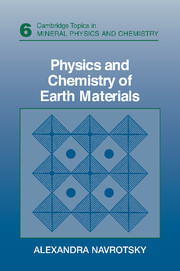Book contents
- Frontmatter
- Contents
- Acknowledgments
- 1 Introduction
- 2 Crystal chemistry
- 3 Experimental methods for studying structure
- 4 Methods for studying thermodynamic properties
- 5 Chemical bonding
- 6 Mineral thermodynamics
- 7 Solid solutions and order–disorder
- 8 Melts, glasses, and amorphous materials
- 9 The interface between mineral physics and materials science
- Index
6 - Mineral thermodynamics
Published online by Cambridge University Press: 05 June 2012
- Frontmatter
- Contents
- Acknowledgments
- 1 Introduction
- 2 Crystal chemistry
- 3 Experimental methods for studying structure
- 4 Methods for studying thermodynamic properties
- 5 Chemical bonding
- 6 Mineral thermodynamics
- 7 Solid solutions and order–disorder
- 8 Melts, glasses, and amorphous materials
- 9 The interface between mineral physics and materials science
- Index
Summary
Linking macroscopic and microscopic
Thermodynamic parameters (enthalpies, entropies, free energies) are useful in at least two ways. First, they are essential to understanding the pressure, temperature, and composition ranges over which a phase is stable. In earth sciences, geothermometers and geobarometers based on thermodynamic formalisms (and real thermodynamic data or a spectrum of sound to shaky empirical calibrations) serve to decipher geologic history (pressure, temperature, oxygen fugacity, compositional constraints as a function of time) from phases present in a rock. In materials science, synthesis and processing, compatibility, and device degradation are governed by thermodynamic (and kinetic) parameters. In both geologic and materials processes, heat balance, energy input/output of a reacting system, and rates of heating and cooling are governed by heat capacities, heats of chemical reaction and phase change, and thermal conductivity. Thus macroscopic thermochemical parameters have important practical uses.
Second, thermochemical parameters, especially when analyzed systematically for a group of materials with the same structure but different compositions or for a set of polymorphs, give insight into structure and bonding, that is, into the microscopic (atomistic) realm. Such systematic considerations in turn let one make rational estimates of thermodynamic properties that have not yet been measured and to predict under what conditions a phase transition is likely or a new structure might form. Such predictions are especially useful for extreme conditions of pressure and temperature like those found in the interior of the Earth and other planets.
- Type
- Chapter
- Information
- Physics and Chemistry of Earth Materials , pp. 273 - 331Publisher: Cambridge University PressPrint publication year: 1994



